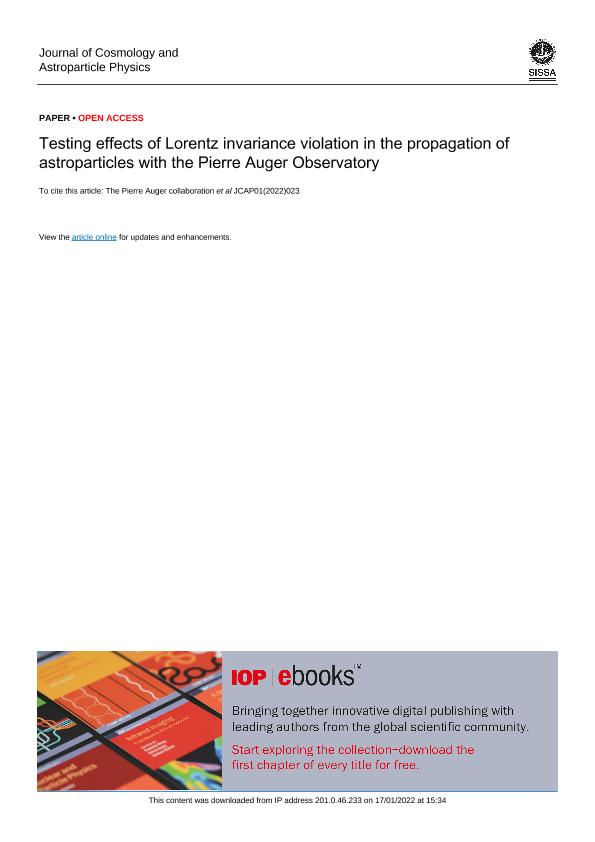Artículo
Testing effects of Lorentz invariance violation in the propagation of astroparticles with the Pierre Auger Observatory
The Pierre Auger Collaboration; Rovero, Adrian Carlos ; Scornavacche, Marina Andrea
; Scornavacche, Marina Andrea ; Perlin, Matias
; Perlin, Matias ; González, Nicolás Martín
; González, Nicolás Martín ; Botti, Ana Martina
; Botti, Ana Martina ; Gollan Scilipotti, Fernando Daniel
; Gollan Scilipotti, Fernando Daniel ; Figueira, Juan Manuel
; Figueira, Juan Manuel ; Supanitsky, Alberto Daniel
; Supanitsky, Alberto Daniel ; Gesualdi, Flavia
; Gesualdi, Flavia ; Cobos Cerutti, Agustin Cleto
; Cobos Cerutti, Agustin Cleto ; Mariazzi, Analisa Gabriela
; Mariazzi, Analisa Gabriela ; Kizakke Covilakam, Varada Varma
; Kizakke Covilakam, Varada Varma ; Micheletti, Maria Isabel
; Micheletti, Maria Isabel ; Rovero, Adrian Carlos
; Rovero, Adrian Carlos ; Bonifazi, Carla Brenda
; Bonifazi, Carla Brenda ; Binet, Maria Virginia
; Binet, Maria Virginia ; Bertou, Xavier Pierre Louis
; Bertou, Xavier Pierre Louis
 ; Scornavacche, Marina Andrea
; Scornavacche, Marina Andrea ; Perlin, Matias
; Perlin, Matias ; González, Nicolás Martín
; González, Nicolás Martín ; Botti, Ana Martina
; Botti, Ana Martina ; Gollan Scilipotti, Fernando Daniel
; Gollan Scilipotti, Fernando Daniel ; Figueira, Juan Manuel
; Figueira, Juan Manuel ; Supanitsky, Alberto Daniel
; Supanitsky, Alberto Daniel ; Gesualdi, Flavia
; Gesualdi, Flavia ; Cobos Cerutti, Agustin Cleto
; Cobos Cerutti, Agustin Cleto ; Mariazzi, Analisa Gabriela
; Mariazzi, Analisa Gabriela ; Kizakke Covilakam, Varada Varma
; Kizakke Covilakam, Varada Varma ; Micheletti, Maria Isabel
; Micheletti, Maria Isabel ; Rovero, Adrian Carlos
; Rovero, Adrian Carlos ; Bonifazi, Carla Brenda
; Bonifazi, Carla Brenda ; Binet, Maria Virginia
; Binet, Maria Virginia ; Bertou, Xavier Pierre Louis
; Bertou, Xavier Pierre Louis
Fecha de publicación:
01/2022
Editorial:
IOP Publishing
Revista:
Journal of Cosmology and Astroparticle Physics
ISSN:
1475-7516
Idioma:
Inglés
Tipo de recurso:
Artículo publicado
Clasificación temática:
Resumen
Lorentz invariance violation (LIV) is often described by dispersion relations of the form E i2 = m i2+p i2+δi,n E 2+n with delta different based on particle type i, with energy E, momentum p and rest mass m. Kinematics and energy thresholds of interactions are modified once the LIV terms become comparable to the squared masses of the particles involved. Thus, the strongest constraints on the LIV coefficients δi,n tend to come from the highest energies. At sufficiently high energies, photons produced by cosmic ray interactions as they propagate through the Universe could be subluminal and unattenuated over cosmological distances. Cosmic ray interactions can also be modified and lead to detectable fingerprints in the energy spectrum and mass composition observed on Earth. The data collected at the Pierre Auger Observatory are therefore possibly sensitive to both the electromagnetic and hadronic sectors of LIV. In this article, we explore these two sectors by comparing the energy spectrum and the composition of cosmic rays and the upper limits on the photon flux from the Pierre Auger Observatory with simulations including LIV. Constraints on LIV parameters depend strongly on the mass composition of cosmic rays at the highest energies. For the electromagnetic sector, while no constraints can be obtained in the absence of protons beyond 1019 eV, we obtain δγ,0 > -10-21, δγ,1 > -10-40 eV-1 and δγ,2 > -10-58 eV-2 in the case of a subdominant proton component up to 1020 eV. For the hadronic sector, we study the best description of the data as a function of LIV coefficients and we derive constraints in the hadronic sector such as δhad,0 < 10-19, δhad,1 < 10-38 eV-1 and δhad,2 < 10-57 eV-2 at 5σ CL.
Palabras clave:
COSMIC RAY EXPERIMENTS
,
ULTRA HIGH ENERGY COSMIC RAYS
Archivos asociados
Licencia
Identificadores
Colecciones
Articulos (ICIFI)
Articulos de INSTITUTO DE CIENCIAS FISICAS
Articulos de INSTITUTO DE CIENCIAS FISICAS
Articulos(IAFE)
Articulos de INST.DE ASTRONOMIA Y FISICA DEL ESPACIO(I)
Articulos de INST.DE ASTRONOMIA Y FISICA DEL ESPACIO(I)
Articulos(IFIBA)
Articulos de INST.DE FISICA DE BUENOS AIRES
Articulos de INST.DE FISICA DE BUENOS AIRES
Articulos(IFIR)
Articulos de INST.DE FISICA DE ROSARIO (I)
Articulos de INST.DE FISICA DE ROSARIO (I)
Articulos(IFLP)
Articulos de INST.DE FISICA LA PLATA
Articulos de INST.DE FISICA LA PLATA
Articulos(ITEDA)
Articulos de INSTITUTO DE TEC. EN DETECCION Y ASTROPARTICULAS
Articulos de INSTITUTO DE TEC. EN DETECCION Y ASTROPARTICULAS
Citación
The Pierre Auger Collaboration; Rovero, Adrian Carlos; Scornavacche, Marina Andrea; Perlin, Matias; González, Nicolás Martín; et al.; Testing effects of Lorentz invariance violation in the propagation of astroparticles with the Pierre Auger Observatory; IOP Publishing; Journal of Cosmology and Astroparticle Physics; 1; 23; 1-2022; 1-23
Compartir
Altmétricas



